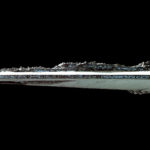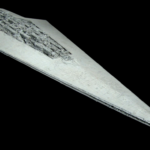Dreadnoughts are the largest ships in any Navy, and include the ‘Titans’ of EVE Online.
–
Table of Contents:
- Vocabulary
- History of the Dreadnought Class
- Intended Application
- Very Long Range Weapons Systems and Platforms
- Example Images
–
Vocabulary:
-
historical: a type of battleship introduced in the early 20th century, larger and faster than its predecessors and equipped entirely with large-caliber guns.
–
History of the Dreadnought Class:
Though humanity has never officially encountered a formidable or even sentient alien civilization, it continues to produce greater sizes and technology levels with its ships, A.I.s, and kits. Why?
At first there were aircraft carriers, then submarine-carrier hybrids, next came extra-orbital space stations along with privatized commercial civilian space travel (courtesy, the Virgin Galactic corporation), and finally colony ships and illegal free-lance mining and colonization efforts. Eventually Earth‘s resources ran dry (or so the story goes) and world-ships like the tri-tower city-ships and arks of the Firefly storyline came onto the scene. There were even ship models that mimicked the ships seen during the Armageddon War that seemed to be on a coastal invasion campaign to wipe out all of mankind (though those ships have long since vanished back into the great unknown as quickly as they’d come).
It all seems to point to one thing: healthy intra-species rivalry and competition (and fairly routine violent uprisings). Thus, the massive Dreadnought Class was formed –now fielding nearly a thousand of its kind.
–
Intended Application:
Dreadnoughts, like carriers, typically require smaller escort-ships and fighter complements for protection, and often take up low orbits in order to drop barrages of ‘kinetic impact rods’ (usually predominantly composed of tungsten). Carpet-bombing from Space allows for much of their ordnance to be non-explosive; it only causes massive damage after falling through an atmosphere and reaching terminal velocity. This makes work aboard these Spacecraft much safer, and the risk of a catastrophic chain-reaction much less. Dreadnoughts also have powerful laser and maser turrets, the latter of which can be fired with virtually no adverse affects except where two or more beams cross on (or within) a target, thereby bypassing most bunker layers or ship armor, and reducing unintended casualties (such as small fighter-craft and pilots who happen to be near or in the beams). In other words, a Dreadnought can fire through swarms of other Spacecraft and only hit the intended target. They are not powerful enough to create an E.L.E. or destroy a planet, but can easily disable and destroy numerous other large Spaceships.
For reference:
- Frigates are usually the smallest vessel any military will employ/deploy; they are for simple patrolling.
- Destroyers are fast-attack; not meant for prolonged engagements (i.e. battles).
- Cruisers are usually for defense against fighter-jets and other small to midsized craft, and can do some nearby-shore (lateral) bombardment.
- Battlecruisers are usually for heavy reconnaissance; they are not meant for battles, but are the bigger, faster, more heavily-armed version of cruisers, able to speed through enemy lines to scout for enemy fleets, and defend themselves on the way out, if need be.
- Battleships are for normal battles/engagements, and do not carry many/any smaller ships.
- Bombers are for dropping bombs on worlds, whether from atmosphere or orbit.
- Carriers focus on carrying the most other/smaller ships; they are mobile air/Spaceports.
- Dreadnoughts are for engaging (if not one-shotting; sometimes they need a couple shots to fully disable/destroy their targets) any big ship (though it takes several shots/barrages from them to take down a Titan).
- Titans are for one-shotting capital ships (the biggest ships in any fleet/armada).
–
Very Long Range Weapons Systems and Platforms:
Using targeting lasers and firing computers, larger and more sophisticated ships, bases, and artillery pieces can accurately engage targets on other moons, from moon to planet, or from a planet to its moon(s). Space-naval ships can fire lasers and shells extremely long distances between planets, and calculate how each planet’s gravity will curve the laser or shell, hitting targets on the other side of worlds by making use of this gravity slingshot effect, curving the trajectory and speeding up the projectile before impact. These ships are also able to detect and fire through dense areas of space, like nebulae, dead star coronas, wormholes, and gravity-rivers, all of which pull on the projectile, curving its trajectory, and making it very processor-consuming for AI computer systems to figure out where all of the projectiles are going.
–
–






















